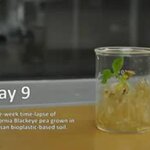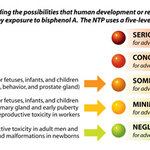Chemistry
Does BPA make you fat?
As
with most questions related to the common chemical bisphenol A (BPA), the answer to that question may depend on who you
ask. The question is a particularly
relevant one in recent years with the advent of the “environmental obesogen”
hypothesis, which refers to “…chemicals
that inappropriately alter lipidhomeostasis and fat storage, metabolic
setpoints, energy balance, or the regulation of appetite and satiety to promote
fat accumulation and obesity.”
The hypothesis further suggests that exposure to so-called obesogens
can cause an array of medical conditions…

Bisphenol A (BPA) is currently banned from baby bottles so the search is on for alternatives.
Lignin, the compound that gives wood its
strength, from waste in paper manufacturing could be ready for the market within five years, according to a paper at the National Meeting of the American Chemical Society.
There is no evidence of harm due to BPA despite 50 years of common use but some critics allege it mimics the hormone estrogen and that it might be unsafe for young children and pregnant women in ways as yet undiscovered. Parents scared by the precautionary principle and the…

Vibrations in chemical bonds can be used to predict chemical reactions. That means chemists could design better catalysts to speed reactions that make medicines, industrial products and new materials.
Catalysts are chemicals that speed reactions between other chemicals without changing the catalyst itself. Chemical bonds tie atoms together within molecules. But the bonds are not static. They vibrate. Those vibrations reflect changes in distance between atoms in the molecule. For example, in water (H2O) the sole oxygen atom is bound to two hydrogen atoms, and the two bonds constantly…

Beer drinkers know that hops are what gives the drink its bitterness and aroma. Recently, scientists reported that the part of hops that isn't used for making beer contains healthful antioxidants and could be used to battle cavities and gum disease.
A new identified some of the substances that could be responsible for these healthful effects.
Yoshihisa Tanaka and colleagues note that their earlier research found that antioxidant polyphenols, contained in the hop leaves (called bracts) could help fight cavities and gum disease. Extracts from bracts stopped the bacteria responsible for…
Synthetic spider silk of fantastical, superhero strength is finally speeding toward commercial reality.
The material, which is five times stronger than steel, could be used in products from bulletproof vests to medical implants, according to an article in Chemical&Engineering News (C&EN).
Alex Scott, a senior editor at C&EN, notes that spider silk's impressive strength has been studied for years, and scientists have been trying to make a synthetic version of the super-strong protein in the lab. For other simpler proteins, scientists have been able to insert relevant genes into…

Analysis of the wood from three 17th century shipwrecks in the Baltic Sea, the Ghost wreck, the Crown and the Sword, showed high concentrations of sulfur and iron using X-ray fluorescence (XRF) scanning.
Scientists from the same team have previously reported large amounts of sulfur and iron accumulation in the warship Vasa. In that study, the scientists found an outbreak of acidity and sulphate salts on the surface of the hull and other wooden objects.
Should we be worried if they lasted 400 years? It it true that these biological and chemical processes that occur naturally in low-…

A number of people are concerned about BPA in plastics but that is far less warranted than concern about plastics themselves.
In 1967's "The Graduate", the following conversation took place between an older man and the young protagonist:
McGuire: I just want to say one word to you. Just one word. Benjamin: Yes, sir. McGuire: Are you listening? Benjamin: Yes, I am. McGuire: Plastics.
He was right then, though everyone knew it, and he is even more right today. Recycling is something of a joke, since government recycling mostly consists of sending it to China, and even…

Human exposure to bisphenol A (BPA) has recently been linked to negative health claims, like a decline in reproductive function in adults and stunted neurodevelopment in children, and so people consumed with the 'natural' fallacy have been up in arms about it. It hasn't quite become 'BPA causes autism' hysteria, like they did with vaccines, but it is getting close.
Naturally, companies have listened to the nocebo worries of the natural-obsessed and dutifully created BPA-free products and charged more money for them.
The methodology of those claims has been suspect, though that is…

Hemp plants with scientifically enhanced increase in oleic acid could lead to an attractive cooking oil that is similar to olive oil in terms of fatty acid content - but has a much longer shelf life as well as greater heat tolerance and hopefully a lot less fraud associated with it than olive oil has.
Using fast-track molecular plant breeding, the scientists selected hemp plants lacking the active form of an enzyme involved in making polyunsaturated fatty acids. These plants made less poly-unsaturated fatty acids and instead accumulated higher levels of the mono-unsaturated oleic acid. The…

The subject of endocrine disruption is not particularly new, with extensive scientific and regulatory attention to endocrine disrupting chemicals (EDCs) over the last 20 years or so. A common definition, from the World Health Organization/International Programme on Chemical Safety, is:
An endocrine disruptor is an exogenous substance [i.e. a substance not originating in an organism] or mixture that alters function(s) of the endocrine system and consequently causes adverse health effects in an intact organism, or its progeny, or(sub)populations.”
Quite a few natural and synthetic chemicals…